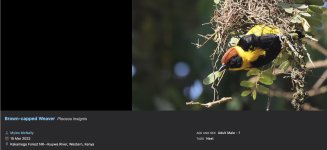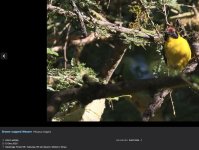Referring back to my post #18 and Val35's post #20.
Since I'm leading such an exciting life these days, I had time to go through all the 185 photos labelled 'Brown-capped Weaver' on the Macaulay photo library to classify them by sex and throat colour. Here are my results.
Almost all the photos from Kenya are from Kakamega/Rondo (a few from Mount Kenya or elsewhere), and almost all the photos from Uganda are from Bwindi (a couple from Rwanda). There are also a couple from Cameroon which had black throats, but I have ignored. There were about 11 photos where I couldn't even work out if it was a male or a female, let alone the throat colour, which have also been ignored here. I also counted multiple photos of the same bird just once (but I may have missed once or twice). This is just an indicative count; don't get back at me on absolutely exact numbers. 'Couldn't decide' is that you can see part of the throat but not at an angle or in light where you ('I') can be sure. There were three photos which clearly showed other species of weaver.
The few juveniles in Macaulay had a yellow throat but also obvious juvenile features, and have not been included in these figures.
Kenya:
Male black throat - 31 + 4 probable
Male yellow throat - 2
Male couldn't decide - 3
Female black throat - 8 + 1 probable
Female yellow throat - 1 probable
Female couldn't decide - 3
Uganda:
Male black throat - 4 + 2 probable
Male yellow throat - 12 + 3 probable
Male couldn't decide - 7
Female black throat - 2 + 2 probable
Female yellow throat - 15 + 2 probable
Female couldn't decide - 18
Analysis
Bwindi and Kakamega are remnant rainforest areas which are no longer joined and so the two populations are disjunct and one would assume don't mix (600km with Lake Victoria in the way).
Birds in western Kenya, both males and females, have overwhelmingly a black throat (though two males at least had a clear yellow throat - photos attached below; I hope this is 'fair use' - I made sure to include the credits (I can't work out how to get those blue Macaulay bars that Val35 has - I'm willing to be taught).
Birds in western Uganda, both males and females, have a strong preponderance of yellow throats, by at least 3 to 1.
The sample of 185 photos (some are duplicates, so I estimate about 130 individual birds, but 100 at least) is reasonable. If the yellow throat was a feature of age or sex, then one would expect the ratio of black to yellow throats to be the same in both countries with a decent sample size like this; but it isn't.
So, it seems to me clear that there is an obvious visual difference between the two populations, which is statistically signinficant, even if there seem to be a few members of the other group in each location.
It's a bit strange that the books (and online sites like Birds of the World) don't mention the yellow-throated form of this species - even if it
were a sex or age thing, it seems from the photos to be so common that it should be mentioned. Baglafecht's various subspecies are always distinguished.
I wonder if there are any of the great Africa experts on here who can shed light on this? To repeat myself, it doesn't seem to be an artefact, or just down to chance. There seems to be a strong visual difference between these two populations, yet one variant isn't mentioned. Why?
View attachment 1478273 View attachment 1478276







